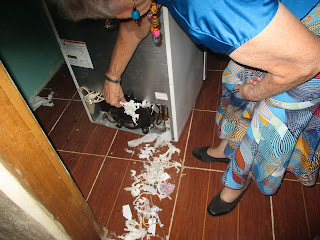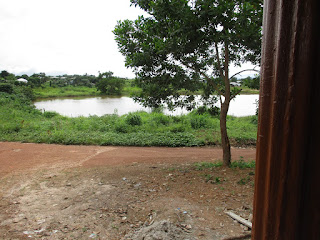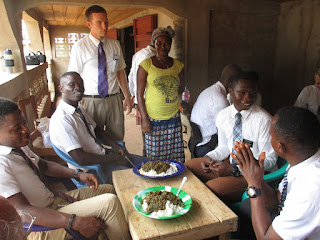In Western Africa there are three types
of wedding ceremonies. Traditional, church, and civil. All are
recognized as legal marriages in Sierra Leone and by the Church of Jesus Christ of Latter-Day Saints. We were honored to be
invited to the wedding ceremony of our good friend Solomon and his
fiance Ngadi. They had chosen to do both the traditional ceremony
followed by the civil ceremony 2 days later. Each tribe has their
own traditions. They are mostly the same but vary a bit by tribe.
This was the Mende tribe ceremony.
Traditional Wedding
When we arrived for the traditional
ceremony, the bride and groom were dressed very casually and were
mingling among the guests who were sitting and visiting around a
large courtyard. We visited with them and others.
Notice the matching t-shirts that
several of the bridal party were wearing.
 |
| Back |
 |
| Front |
They were preparing the stew for the
bridal feast in a huge pot over the fire.
Traditional Ceremony
About and hour after we arrived, we
were invited to go into the house as they were preparing to start
the ceremony. There were about 30 chairs in the house filling the
dining room and parlor. We were seated on the groom's family side.
We were the first ones in besides the two tribal leaders.
15 members of the bride's family were
invited in and they filled half of the room. The door was then
closed. There then was a loud knock at the door. The bride's father
answered the door, asked who was there and what did they want. He
said I don't know you. He was told they had come to get acuainted
and if he would let them in they would explain what they wanted.
Would you please let us in. He opened the door and 13 members of the
groom's family came in. We already were seated in 2 of their
chairs. They all sat on the same side of the room as us. The rest
of both families stayed outside but they could hear the proceedings
over the speakers as they were using microphones.
The chief invited the muslim pastor on
the bride's side to say the muslim prayer. Ngadi's grandfather was
the person who gave that prayer. He then invited the Christian
pastor on the gooms side to give the Christian prayer. A member of
the Bo North LDS District presidency gave that prayer.
The chief then introduced all the
members of the bride's family. He paid special tribute and honor to
the oldest member. The groom's family was then introduced and again
paid honor and tribute to the oldest member. He then asked who was
speaking for the groom. The president of the Bo East LDS District
stood up and said he was representing the groom. The chief then
asked him what inquires did he want to make.
He said that the groom had become
attached to the most beautiful flower growing in the bride's family
garden and wished to take that flower for himself and take it to his
home with him. To help persuade them he had sent gifts to the bride's
family. (Note; Originally these gifts were cola nuts which were very
expensive and used as currency among the tribes. Today they used
cash.) He then gave separate envelopes to the bride's father and
mother, maternal and paternal grandparents, one for all the aunties,
one for the uncles, one for the brothers and one for the sisters, and
last of all one for the bride. The bride's family consulted and said
they were in agreement.
The bride's family brought a jar of
cola nuts and water and presented it to the groom's family. The
groom's family brought out a bundle of cola plant starts, wrapped in
leaves and presented it to the the bride's family.
They then called for the bride to be
brought in. There was a delay, and a bridesmaid said she didn't
want to come out. She was given a small amount of cash. She went
back into the room, returned and said she still doesn't want to come
out. She was given more cash and then a veiled young woman was
ushered into the room amid sorrowful chanting. They unveiled her and
asked “Is this the flower you are looking for?” It was the
bride's sister. The groom's family said no, no, no and made a big
protest. They took her back into the dressing room and after a couple
more exchanges of money, brought in the bride.
The groom's family agreed that she was
the one. She was seated in the middle of the room and given the
envelope for the bride.
The father then asked her if she knew
the groom and if she agreed to the proposal of marriage. There was a
hush as everybody waited for her answer. She said she knew him and
the groom's family cheered. The groom's family said they had a gift
for her and presented her with a calabash (Note: A calabash is a
very large goard bowl) containing a gift of great value. The bride
and groom had previously agreed what this was going to be. It could
be anything like a lump of gold, a diamond, or some livestock.
Traditionally it was like an insurance policy. If her husband were
to die it would give her the means to take care of herself and her
children. The calabash also contained some sugar which signified that
the groom would share all of the sweet times and everything he had
with her. There was also something bitter, some buttons, a needle
and thread, a cloth wrap and two straw mats. These represented her
commitment to stay with him thru the hard times; to sew on lost
buttons on his shirt and mend his clothes and if he couldn't provide
her with a bed, to spread her mat next to his on the floor until
times got better. This calabash was passed around and inspected by
all the members of the family and then returned to her. The chief
then asked her if she accepted the calabash. She stood up, took the
calabash and gave it to her mother for safe keeping. The groom's
family cheered again.
The groom was then called for.
He came in wearing the traditional
clothing which matched her dress and was met by greetings and
cheering from both families. He was seated next to the bride. He
was then told that the bride had accepted the calabash and asked if
she was the one that he wanted. He said yes. The chief then asked
him if he had been previously married. He said yes but was legally
divorced. There was murmur of approval from the bride's family. He
was then asked if he had any children. He said he had a boy and a
girl that were legally in his custody and care. The chief asked the
bride if she knew of the children. She said yes. He then asked her
if she were willing to take those children as her own and help raise
them. She said yes. The chief then asked the bride if she had any
children. She said yes, she had one. He then asked the groom if he
knew about this child and if he was willing to take this child as his
own and help raise him. He said yes.
The groom was then asked for the names
of a male and a female god parent from his family. He gave those
names, they were called forward and stood by the bride and groom.
The bride was then asked for the names of a male and a female god
parent from her family. She gave those names, they were called
forward and stood by the bride and groom. The chief then asked the
god parents if they accepted their role as protectors of the
marriage. The chief then counseled with the couple, that when there
was trouble in the marriage that they would turn to these 4 people
for help and advice and not to others. These 4 people would be there
for strength and help to solve their problems. They would do
everything they could to keep the marriage from failing. They would
be their best friends.
The chief then asked the two god
fathers to clasp hands. He then took the veil from the bride and
wrapped it around their joined hands. The chief then indicated that
this couple were now married for this life and the next in the eyes
of the tribe. The groom's family brought the ring and Solomon placed
it on the bride's left hand.
A member of the Bo North LDS district
presidency gave a closing prayer.
Here we see a picture of the bride and
groom after the traditional ceremony.
A large plate of food was brought out
for everyone. There was music and dancing and lots of visiting.
Most of the guests outside were already being fed when the two
families came out.






















































